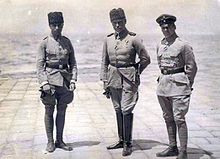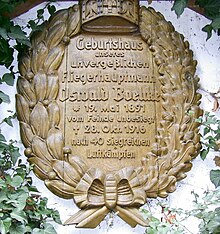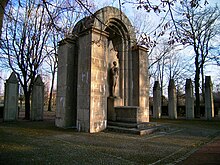Oswald Boelcke

Oswald Boelcke (* 19th May 1891 in Giebichenstein , Saalkreis ; † 28. October 1916 at Bapaume , Pas-de-Calais , France ) was one of the most famous German fighter pilot in the First World War . With the Dicta Boelcke he developed the first operational principles of aerial combat tactics .
Military career
Military training
Boelcke grew up in Dessau (at that time the Duchy of Anhalt ) as the son of high school professor Max Boelcke, who came from an established family of craftsmen in Brandenburg an der Havel . After graduating from high school, he joined the Telegraph Battalion No. 3 in Koblenz in 1911 as a flag boy . After completing his officer training, Oswald Boelcke joined the newly founded air force in May 1914, just like his brother Wilhelm Boelcke , who was five years older than him . He was trained as a pilot at the Halberstadt Aviation School .
Field pilot
After the last flight test on August 15, 1914, Boelcke was transferred to Feldfliegerabteilung 13 . On the western front he flew with his brother Wilhelm as an observer. After disputes within the unit, the brothers could no longer be used together. Oswald Boelcke came to the newly established Feldfliegerabteilung 62 in April 1915. The department was moved to Douai (France) shortly afterwards .
On July 4, 1915 Boelcke achieved his first aerial victory. The flight observer from Wühlisch achieved the actual shooting down, as in this early phase of the air war the pilots were not yet using any weapons. This first aerial victory in a targeted fighter mission promoted the military idea of establishing units with fighter planes specifically for the fight against enemy aircraft.
Fighter pilot
He achieved Boelcke's first victory in the air as a pilot on September 19, 1915. On January 12, 1916, together with the Saxon Lieutenant Max Immelmann, he was awarded the highest Prussian bravery award, the Order Pour le Mérite , for the eighth victory in the air by Kaiser Wilhelm . Both were the first members of the air force to receive this medal.
There is a story from this period from August 28, 1915. Boelcke saved the life of a French boy who had fallen into a canal. He jumped into the canal and got the boy out of the water. For this he received the Prussian Rescue Medal on a ribbon , which he later proudly wore alongside his other awards.
In March 1916, Boelcke became the leader of a group of six fighter pilots in the newly established Sivry squadron . At that time, Immelmann and Boelcke dominated the aerial warfare and competed for the most aerial victories. After Immelmann's accidental death on June 18, 1916, Boelcke was banned from flying because his knowledge of fighter flying was considered too valuable. At this point he had achieved 19 recognized aerial victories.
instructor

Boelcke was sent on an inspection trip to the Balkans . On the trip he had contact with Enver Pascha , General Field Marshal Paul von Hindenburg , Erich Ludendorff , General Field Marshal August von Mackensen , General Field Marshal Franz Conrad and Kaiser Wilhelm II. The fact that, as a low-ranking officer, he spoke to leading military and state figures of the Central Powers is illustrated Boelcke's enormous popularity and the high level of general attention paid to air warfare.
After the reorganization of the German air forces suggested by him , Boelcke, meanwhile promoted to captain , was appointed commander of Fighter Squadron 2 , which was set up on August 10, 1916 . He was given the opportunity to choose the pilots himself. During a visit to his brother Wilhelm in Kovel , Russia , he selected lieutenants Manfred von Richthofen and Erwin Böhme as well as deputy sergeant Hans Reimann from among the pilots of Kampfgeschwader 2 .
At the beginning of September 1916, Boelcke began to train his students in single-seater combat. In view of the novelty of targeted aerial combat , he developed the first operational principles for this type of war, in particular flying in close formations. His rules, recorded in the so-called Dicta Boelcke , have been part of the theoretical basis of aerial warfare for many decades. In the short time he was the leader of the hunting squadron, Boelcke was very successful. From the beginning of September to the end of October 1916 he shot down 20 enemy aircraft and was at the top of all fighter pilots with a total of 40 recognized aerial victories.
On October 28, 1916, his machine hit the machine of his comrade Böhme during an air battle. One of Boelcke's wings was damaged. He could no longer intercept the spinning machine and was killed on impact.
Boelcke was buried in a state funeral with great public attention in the honorary cemetery of the city of Dessau-Roßlau . His large tomb, created in 1921 as a joint work by the architect Albin Müller and the sculptor Walther Kieser , can still be viewed there today .
Boelcke's merits lie in the development of the operational principles of modern fighter flying and pilot training. His Dicta Boelcke , rules for air combat, still apply today.
Military awards
- Iron Cross (1914) 2nd and 1st class
- Friedrich-Kreuz on January 31, 1915
- Knight's Cross of the Royal House Order of Hohenzollern with swords on November 3, 1915
- House Order of Albrecht the Bear Knight's Cross 2nd class with swords (silver) and 1st class (gold)
- Military Merit Order (Bavaria) IV class with swords on November 13, 1915
- Rescue medal on ribbon (Prussia) on November 30, 1915
- Honor goblet for the winner in the aerial combat on December 24, 1915
- Pour le Mérite on January 12, 1916
- Iron Crescent on July 23, 1916
- Duke of Saxony-Ernestine House Order Knight's Cross 1st Class with Swords on July 31, 1916
- Military Order for Valor IV Class on August 9, 1916
- Order of the Iron Crown III. Class with the war decorations on October 29, 1916
Naming
- Immediately after Boelcke's death, the unit he commanded was renamed “Jagdstaffel Boelcke”.
- The Imperial Navy named the outpost boat Boelcke after him .
- In Brandenburg an der Havel there was the "Oswald-Boelcke-Platz" (today Alfred-Messel-Platz) from 1934 to 1945.
- When an independent air force was set up under Hermann Göring under National Socialism in 1935 , the first squadrons were named after Max Immelmann, Manfred von Richthofen and Oswald Boelcke on the orders of Adolf Hitler . So a line of tradition was to be constructed from the air force of the First World War to the National Socialist Air Force. See Kampfgeschwader 27 “Boelcke” .
- In Königsberg a barracks was given the name Boelcke barracks
- In the "Fliegerviertel" in Berlin-Tempelhof - bordering the former airfield - Boelckestrasse has been named after him since 1936.
- The barracks in Koblenz, where Boelcke began his military service in 1911, was also renamed Boelcke barracks by the National Socialists in 1938 .
- A Boelcke barracks also existed in Ulm from 1934 to the mid-1990s .
- The Feldwebel-Lilienthal-Kaserne in Delmenhorst was also called Boelcke-Kaserne during the Nazi regime .
- In 1942, the Luftwaffe named one of their air traffic control vessels Boelcke .
- The Air Force of the Armed Forces has the Tactical Air Force Squadron 31 "Boelcke" in Nörvenich also named a unit for him. The barracks in Kerpen belonging to the squadron are called Boelcke-Kaserne and are located on Boelckestrasse. It is to be closed by 2019 [obsolete] .
- In Kiel-Holtenau , Boelckestrasse at the airfield is named after him.
- In Mainz-Kastel a main road was named "Boelckestrasse" after him.
- The Boelckestrasse near the former Würzburg air base was renamed Am Galgenberg after 1945 .
- There has been a Boelckestrasse in Nörvenich for many years. In June 2012 the access to the Nörvenich Air Base was named Oswald-Boelcke-Allee .
- In Freiburg im Breisgau a street in the so-called Heldenviertel ( Unterwiehre ) is named after Boelcke.
- In Münster there is a Boelckeweg near the former Münster / Loddenheide airport.
- In Langenhagen (near Hanover) there was also a Boelcke barracks until 1992. The Air Defense Regiment 1 was based there until 1992.
- In Lage (Lippe) there is a residential street called Boelckestraße, while most of the streets in the same district are named after classical composers.
- There is a Boelckeweg in Osnabrück . In addition, streets in the residential area are named after Berthold, Immelmann, Richthofen and Tiling.
- The Boelcke barracks was a Luftwaffe barracks built in 1936 with large hangars in southeastern Nordhausen . The location was used under the name " KZ-Außenlager Boelcke-Kaserne " from January 8, 1945 to April 11, 1945 as a satellite camp of the Mittelbau concentration camp for male concentration camp prisoners.
- In Stade (Lower Saxony) there is still a Boelckestrasse today (2016).
- A Boelckestrasse still exists in Rendsburg today. Streets for Richthofen, Hirth, Lilienthal, Immelmann, Graf Zeppelin and Preuss are also represented in the quarter.
- In Wildeshausen you can still find the names of the air pioneers Immelmann, Richthofen, Lilienthal, Heinkel, Junkers, Zeppelin and Oberth near Boelckestrasse.
- In the so-called Fliegerviertel in Landau in the Palatinate, there are, in addition to Boelckestraße, other streets that were named after the German pilots and aviation pioneers Richthofen, Eckener, Immelmann and Graf Zeppelin.
- There is also an Oswald-Boelcke-Straße in Wunstorf .
See also
literature
- Heinz Kraft: Boelcke, Oswald. In: New German Biography (NDB). Volume 2, Duncker & Humblot, Berlin 1955, ISBN 3-428-00183-4 , p. 398 ( digitized version ).
- Arch Whitehouse: Flieger-Ase 1914-1918 . Motorbuch, Stuttgart 1970, pp. 365-377 DNB 458639915 .
- Walter Waiss: Chronicle of Kampfgeschwader No. 27 Boelcke, Part 3: 1.1.42–31.12.42 . Helios, Aachen 2005, ISBN 3-938208-07-4 .
- Norman Franks: Albatross Aces of World War 1 . Osprey, Oxford / New York 2000 (= Aircraft of the Aces; 32), ISBN 1-85532-960-3 .
- Greg Van Wyngarden: Season 2 'Boelcke'. From Richthofen's mentor . Osprey, Oxford / New York 2007 (= Aviation Elite Units; 26), ISBN 978-1-84603-203-5 .
- Erich Gröner u. a .: The German warships 1815-1945 , Vol. 8/2: Outpost boats, auxiliary minesweepers, coastal protection associations (part 2), small combat associations, dinghies , Koblenz (Bernard & Graefe) 1993, p. 533. ISBN 3-7637-4807-5
Web links
- Literature by and about Oswald Boelcke in the catalog of the German National Library
- Works by and about Oswald Boelcke in the German Digital Library
- Newspaper article about Oswald Boelcke in the 20th century press kit of the ZBW - Leibniz Information Center for Economics .
- Works by Oswald Boelcke in the Gutenberg-DE project
- Brief profile and list of aerial victories , theaerodrome.com (English)
Footnotes
- ↑ A few hours before his death, on the same day, he had written to his family: “Mother need not imagine the circumstances and dangers in which I am floating in such a gruesome way. You just have to think about the plus in experience and routine with which I go into every fight ... "
- ^ Königsberg (Pr.), Hünefeldstrasse, Boelcke barracks. bildarchiv-ostpreussen.de, accessed on April 10, 2018 .
- ↑ Boelckestrasse. In: Street name lexicon of the Luisenstädtischer Bildungsverein (near Kaupert )
- ↑ Jakob Knab : False Glorie: the traditional understanding of the Bundeswehr. Ch.links, Berlin 1995, ISBN 3-86153-089-9 , p. 38
- ↑ Andreas D. Becker: Ever since a model assembly group recreated the former Boelcke barracks, more and more questions have arisen: Mysterious Adelheide air base. In: Delmenhorster Kurier , October 27, 2010.
- ↑ Asylum seekers: Boelcke barracks in good condition. 130 refugees come to Pulheim. In: Kölner Stadt-Anzeiger. July 30, 2015, accessed on October 13, 2016 : "The Boelcke barracks is currently the second location of the Boelcke 31 tactical air force squadron in Nörvenich, but should be closed completely by 2019"
- ↑ Kiel Airport
- ↑ Directory of the concentration camps and their external commands in accordance with Section 42 (2) BEG , No. 1071, Nordhausen / Saxony-Anhalt, Boelcke-Kaserne, Dora-Mittelbau, January 8, 1945 to April 11, 1945
| personal data | |
|---|---|
| SURNAME | Boelcke, Oswald |
| BRIEF DESCRIPTION | German fighter pilot in the First World War |
| DATE OF BIRTH | May 19, 1891 |
| PLACE OF BIRTH | Giebichenstein near Halle (Saale) |
| DATE OF DEATH | October 28, 1916 |
| Place of death | Bapaume , France |



